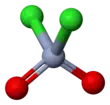| |||
 | |||
| Names | |||
|---|---|---|---|
| Preferred IUPAC name
Chromium(VI) dichloride dioxide | |||
| Systematic IUPAC name
Dichloridodioxidochromium | |||
| Other names
Chromic acid chloride Chromium oxychloride Chlorochromic anhydride Chromic oxychloride Chromium chloride oxide Chromium dioxide dichloride Chromium dioxychloride Chromium oxychloride | |||
| Identifiers | |||
3D model (JSmol) |
|||
| ChEBI | |||
| ChemSpider | |||
| ECHA InfoCard | 100.035.491 | ||
| EC Number |
| ||
| 2231 | |||
PubChem CID |
|||
| RTECS number |
| ||
| UNII | |||
| UN number | 1758 | ||
CompTox Dashboard (EPA) |
|||
| |||
| |||
| Properties | |||
| CrO2Cl2 | |||
| Molar mass | 154.9008 g/mol | ||
| Appearance | Blood-red fuming liquid, similar to bromine | ||
| Odor | Musty, burning, acrid[1] | ||
| Density | 1.911 g/mL, liquid | ||
| Melting point | −96.5 °C (−141.7 °F; 176.7 K) | ||
| Boiling point | 118.5 °C (245.3 °F; 391.6 K) | ||
| Reacts with water | |||
| Vapor pressure | 20 mmHg (20 °C)[1] | ||
| Hazards | |||
| Occupational safety and health (OHS/OSH): | |||
Main hazards |
Toxic, oxidizer, carcinogenic, mutagenic, reacts violently with water[1] | ||
| GHS labelling: | |||
     | |||
| Danger | |||
| H271, H314, H317, H340, H350, H410 | |||
| P201, P210, P280, P303+P361+P353, P305+P351+P338+P310, P308+P313[2] | |||
| NFPA 704 (fire diamond) | |||
| Flash point | noncombustible[1] | ||
| NIOSH (US health exposure limits): | |||
PEL (Permissible) |
none[1] | ||
REL (Recommended) |
Ca TWA 0.001 mg Cr(VI)/m3[1] | ||
IDLH (Immediate danger) |
N.D.[1] | ||
| Safety data sheet (SDS) | Sigma Aldrich - Chromyl Chloride | ||
| Related compounds | |||
Related compounds |
SO2Cl2; VOCl3; MoO2Cl2; WO2Cl2; CrO2F2 | ||
Except where otherwise noted, data are given for materials in their standard state (at 25 °C [77 °F], 100 kPa).
Infobox references | |||
Chromyl chloride is an inorganic compound with the formula CrO2Cl2. It is a reddish brown compound that is a volatile liquid at room temperature, which is unusual for transition metal compounds.
Preparation
Chromyl chloride can be prepared by the reaction of potassium chromate or potassium dichromate with hydrogen chloride in the presence of sulfuric acid, followed by distillation.[3][4]
- K2Cr2O7 + 6 HCl → 2 CrO2Cl2 + 2 KCl + 3 H2O
The sulfuric acid serves as the dehydration agent. It can also be prepared directly by exposing chromium trioxide to anhydrous hydrogen chloride gas.
- CrO3 + 2 HCl ⇌ CrO2Cl2 + H2O
The method used to prepare chromyl chloride is the basis for a qualitative test for chloride: a sample suspected of containing chloride is heated with a mixture of potassium dichromate and concentrated sulfuric acid. If chloride is present, chromyl chloride forms as evidenced by red fumes of CrO2Cl2. Analogous compounds are not formed with fluorides, bromides, iodides and cyanides.
Usage
Test for the presence of chlorides
The chromyl chloride test involves heating a sample suspected to contain chlorides with potassium dichromate and concentrated sulfuric acid. If a chloride is present, chromyl chloride forms, its presence being indicated by the formation of red smoke. Otherwise, no red smoke will obviously appear. No similar compound is formed in the presence of fluoride, bromide, iodide, or cyanide, making this test specific to chlorides.
Reagent for oxidation of alkenes
Chromyl chloride oxidizes internal alkenes to alpha-chloroketones or related derivatives.[5] It will also attack benzylic methyl groups to give aldehydes via the Étard reaction. Dichloromethane is a suitable solvent for these reactions.[6]
Others
CrO2Cl2 can also be used to test for the absence of nitrate ions.
Safety considerations

Chromyl chloride is severely corrosive and easily burns the skin and eyes.[7]
References
- 1 2 3 4 5 6 7 NIOSH Pocket Guide to Chemical Hazards. "#0142". National Institute for Occupational Safety and Health (NIOSH).
- ↑ "Chromyl chloride 200042" (PDF). Sigma-Aldrich. Archived from the original on 2020-09-01.
- ↑ Moody, B.J. (1965). "22". Comparative Inorganic Chemistry (1 ed.). London: Edward Arnold. p. 381. ISBN 0-7131-3679-0.
- ↑ Sisler, Harry H. (1946). Chromyl Chloride [Chromium(VI) Dioxychloride]. Inorganic Syntheses. Vol. 2. pp. 205–207. doi:10.1002/9780470132333.ch63. ISBN 9780470132333.
- ↑ Freeman, Fillmore; DuBois, Richard H.; McLaughlin, Thomas G. (1971). "Aldehydes by Oxidation of Terminal Olefins with Chromyl Chloride: 2,4,4-Trimethylpentanal". Org. Synth. 51: 4. doi:10.15227/orgsyn.051.0004.
- ↑ F. Freeman (2004). "Chromyl Chloride". Encyclopedia of Reagents for Organic Synthesis. doi:10.1002/047084289X.rc177. ISBN 0471936235.
- ↑ Prof CH Gray, ed. (1966). "IV". Laboratory Handbook of Toxic Agents (2 ed.). London: Royal Institute of Chemistry. p. 79.


